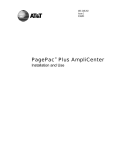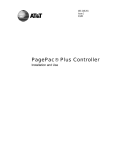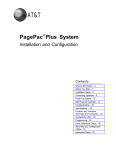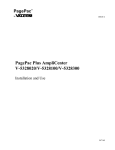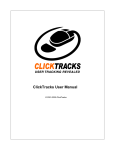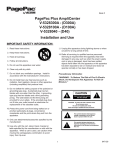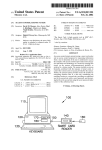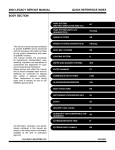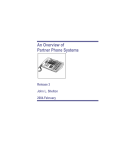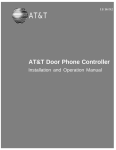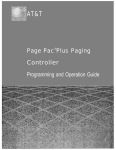Download AT&T PagePac Plus AmpliCenter Specifications
Transcript
AT&T ® PagePac Plus AmpliCenter Installation and Use Contents General Information - 2 Before You Start - 3 Installation Steps - 4 Troubleshooting - 8 Controls and Indicators, Terminals and Connectors - 9 Connecting Speakers - 10 Example System Setups - 11 Connectivity Chart - 12 Specifications - 14 AT&T 463-248-202 0II722051-300 Issue 3, Sept. 1994 Copyright © 1994 Harris Dracon All Rights Reserved Written/Printed in U.S.A. Notice Important Safety Information Every effort was made to ensure that the information in this guide was complete and accurate at the time of printing. However, information is subject to change. Always follow these basic safety precautions when installing and using the system: FCC Statement (Part 15) - Radio Frequency Interference 1. Read and understand all instructions. The PagePac Plus AmpliCenter generates and uses radio frequency energy and if not installed and used in strict accordance with the manufacturer’s instructions, may cause interference to radio and television reception. Testing is being conducted for compliance with the limits for a Class B device in accordance with the specifications in Part 15 of the FCC Rules and Canadian D.O.C. regulations. This testing is designed to provide reasonable protection against such interference. However, there is no guarantee that interference will not occur in a particular installation If this equipment does cause interference to radio or television reception, which can be determined by turning the AmpliCenter unit off and on, the user is encouraged to try to correct the interference by one or more of the following measures: 2. Follow all warnings and instructions marked on the product. 3. DO NOT block or cover the ventilation slots and openings. They prevent the product from overheating. DO NOT place the product in a separate enclosure or cabinet, unless proper ventilation is provided. 4. Never spill liquid on the product or drop objects into the ventilation slots and openings. Doing so may result in serious damage to the components. 5. Repair or service must be performed by a factory authorized repair facility or AT&T technician. - Reorient the radio or TV receiving antenna. 6. The product is provided with a UL-CSA approved, 3-wire ground type plug. This is a safety feature. DO NOT defeat the safety purpose of the grounding type plug. DO NOT staple or otherwise attach the AC power supply cord to building surfaces. - Relocate the AmpliCenter unit with respect to the radio or TV receiver or vice-versa. 7. DO NOT use the product near water or in a wet or damp place (such as a wet basement). - Plug the AmpliCenter unit into a different outlet so that it and the radio or TV receiver are on different branch circuits. 8. DO NOT use extension cords. The product must be installed within 6 feet of a grounded outlet receptacle. If necessary, the user should consult the dealer or an experienced radio/television technician for additional suggestions. The user may find the following booklet, “How To Identify and Resolve Radio-TV Interference Problems,” helpful. This booklet was prepared by the Federal Communications Commission (FCC) and is available from the U.S. Government Printing Office, Washington, DC 20402. Stock order No. 004-000-00345-4. 9. DO NOT install telephone wiring during a lightning storm. Trademarks PAGEPAC, PAGEPAC PLUS and AMPLICENTER are trademarks of Harris Corporation. Centrex is a registered trademark of AT&T. Ordering and Reference Information The order number for this book is 463-248-202. To order copies of this book, call: 1-800-432-6600 in the U.S. and 1-800-255-1242 in Canada. For related product information, refer to the PagePac Plus System Installation and Configuration and Zone Expansion Unit Installation and Use Manual for specific information on those products. 2 10. DO NOT install telephone jacks in a wet location unless the jack is specifally designed for wet locations. 11. Never touch uninsulated wires or terminals, unless the line has been disconnected at the paging or controller interface. 12. Use caution when installing or modifying paging or control lines. Support Telephone Numbers AT&T provides a toll-free customer Helpline 24 hours a day. In the U.S., call the AT&T NTSC Group at 1-800-552-3293 or the AT&T Helpline at 1-800-628-2888 if you need assistance when installing, programming, or using your system. For service or technical assistance in Canada, call one of the following Technical Assistance Centers: Eastern Canada and Ottawa: Ontario: Central and Western Canada: 1-800-363-1882 1-800-387-4268 1-800-663-9817 Domestic and International Approvals UL813, FCC Part 15, Class A, CSA 950, and D.O.C. Before You Start Before installing your system, read and understand the safety instructions. Be sure you have all the necessary parts, tools, and test equipment, listed below. 1 Read Important Safety Information on Page 2 2 Check Shipping Container Contents ■ AmpliCenter Unit ■ Power Cord ■ This Installation and Use guide AMPLICENTER D20, D100, D300 INSTALLATION MANUAL AT&T PagePac Plus AmpliCenter Installation and Use POWER CORD Figure 1. AmpliCenter Components 3 Have Required Tools The following tools are required for the installation of the system hardware and cabling. ■ No. 2 Phillips screwdriver ■ Standard blade screwdriver (1/4") and small, for terminal block connections and level adjustments ■ Wire strippers (24 AWG - 12 AWG) ■ Telephone test set (optional, for troubleshooting) ■ Tone out circuit tester (optional, for troubleshooting) ■ Portable 70V speaker (use cabling pulled for ceiling speakers) (optional, for troubleshooting) ■ Volt-Ohm Meter (optional, for troubleshooting) ■ Four # 8 wood screws, if mounting on wall 3 Installation Steps 1 NOTE: If installed next to other equipment, including the PagePac Plus Controller and Zone Expansion Units, leave at least four inches space above and below for proper ventilation. Mount the PagePac Plus AmpliCenter to either the wall, cabinet or a 19" rack. SIDE VIEW AMPLICENTER Figure 2. Wall Mounted Hardware FRONT DETAIL TYPICAL COMBINATION PAN HEAD PILOT POINT #10 - 32 (TYPICAL) REAR DETAIL POWER STRIP Figure 3. Rack Mounted Hardware 4 2 Connect music input wires to Left, Right, and Ground terminals, if stereo, or Left and Ground, if not. 70V OUT NOTE: The optional audio background music source can be a CD or tape player, AM, FM, or commerical radio, or other audio device. PAGE IN MUSIC IN AMPLICENTER BACK PANEL LOW FREQ CUT-OFF MONO STEREO Figure 4. Music Input Connections on AmpliCenter 3 Hookup speaker cable to AmpliCenter. NOTE: If more than one speaker cable is routed to the AmpliCenter a connector block is necessary. Refer to sample wiring diagrams on page 10. 70V OUT PAGE IN MUSIC IN AMPLICENTER BACK PANEL LOW FREQ CUT-OFF DO NOT hook up speaker wires with AmpliCenter power plug connected! CABLE SHIELDING TO SPEAKERS Figure 5. Speaker Connection on AmpliCenter 4 Connect host telephone system to Amplicenter. NOTE: Connect the 4-wire RJ-11 type plug (used with telephones) to the Page Input connector (far right), or use the Page In terminals. Use Tip and Ring if installing to an existing paging system (low voltage output), VOX activated. Use Tip and Ring if connecting to a Loop Start or Ground Start interface port in host telephone system. With a microphone, hook the mic switch to C1 and Grd, and the mic output to Tip and Ring. Figure 6. Host Telephone System Connection 5 5 NOTE: Refer to the Connectivity Chart on page 12 and 13 to determine the page line output type of your telephone system. In most cases, the setting will be Loop Start. You can also check with your telecommunications manager. Set the AmpliCenter Telephone Mode Selection Switch to match the page output type of your telephone system. Used for input from paging port of Telephone System (PBX) or from Microphone Used to parallel many AmpliCenter inputs without loading the source output Input direct from Telephone System (PBX) with Ground Start Trunk Port Input direct from Telephone System (PBX) with Loop Start Trunk Port Figure 7. Telephone Mode Switch Setting 6 Insert power cord into AmpliCenter and into wall outlet. NOTE: Do not use extension cords or plug into locally, “safety-fused” outlets. 6 FOOT POWER CABLE Figure 8. Power Cable 7 NOTE: If no page is heard, refer to the Troubleshooting Guidelines on page 8. 8 Test paging zone served by the AmpliCenter by dialing paging telephone extension or use microphone. Adjust sound levels using AmpliCenter controls, if necessary. Using a small standard screwdriver, make the following adjustments. See Figure 9. Adjust the Low Frequency Cut Off control. This control cuts out the low frequency bass so that horns and small speakers are not over-driven and distorted by excessive bass energy. Cut off frequency is continuously adjustable from 50Hz (full CCW rotation) to 400 Hz (full CW rotation). 6 The Page VOX (voice activation) sensitivity is turned fully counter-clockwise if the Dry Loop feature is not used. Adjust Music Input level. Clockwise rotation will increase the level. Listen and set to a comfortable level. 4. Using a telephone from the host system, dial the paging extension. Speak into the telephone in a normal manner. Your voice should be heard from all connected speakers. The AmpliCenter Page Input has an automatic level control (ALC) which keeps loud voices and normal voices output at the same level. Beware of paging from a telephone directly under a loudspeaker feedback howl can occur. (An anti-feedback speech processing unit or a record/playback delay unit may solve this problem.) 5. Re-adjust Music Input level to the desired loudness relative to Paging loudness. 6. Some loudspeaker taps may have to be re-adjusted to get even coverage at all locations. Be sure that the final speaker tap setting totals do not exceed the power rating of the AmpliCenter. Adjust Music Ducking level. This feature allows music to continue to be heard during a Page, but at a reduced level. The range is from less than –40 dB (full CCW) to –6 dB (full CW). If music-in is not connected, set to full CCW. 70V OUT PAGE IN MUSIC IN AMPLICENTER BACK PANEL LOW FREQ CUT-OFF Figure 9. Test Page Adjustments 7 Troubleshooting Some common problems encountered when the paging system is not operating are described below. Check each item in the order listed. 1. No AC power to AmpliCenter. 2. Host telephone system failure. 3. Host system page port failure. 4. A hardwire disconnect between host system and PagePac Plus. 5. AmpliCenter switch settings tampered with. 6. Volume low due to DTMF volume level not being set properly. If the problem has not been resolved by checking the preceding items, follow the steps described in the Troubleshooting table that follows. Table 1. Troubleshooting Corrective Action Problem When dialing the Page extension, it does not answer No power to AmpliCenter. Host system not passing call through to AmpliCenter. Telephone Mode Selection Switch not set correctly for host telephone system. Ground start – Tip and Ring reversed or AmpliCenter not grounded. Page extension answers, but page is not heard Audio signal not reaching speakers. Check wiring at AmpliCenter. Verify Page Accessed LED is on. Background music cannot be heard Input level not set correctly. Adjust music input level on AmpliCenter. No power to music source. Verify power is on. Radio off station. Adjust tuner. Music input wires crossed, with signal grounded out. Distorted, garbled, or raspy sound from all speakers connected to AmpliCenter Short circuited speaker leads. Separate. Music input level too high. Turn down. Speaker transformer shorted. Replace. Failed AmpliCenter. Return for repair. Green power LED off AC outlet receptacle is not live. Check outlet circuit breaker or use another outlet. Power cord is loose. Failed AmpliCenter. Return unit for repair. Page access LED won’t go off Page VOX too sensitive. Adjust. C1 lead is grounded. If loop start or ground start, check that only 2 wires (Tip and Ring) are connected by the modular plug cord. 8 Controls and Indicators, Terminals and Connectors Figure 10 shows the controls and indicators, terminals and connectors on the rear panel of the AmpliCenter. Table 2 identifies them by function. AMPLICENTER Figure 10. AmpliCenter Controls and Indicators, Terminals and Connectors Table 2. Controls and Indicators, Terminals and Connectors 1. AC Power in: 105 – 125 VAC, 210-250 VAC, 50/60 Hz, (voltage auto-selectable within unit) 2. 0dBm out, an auxiliary output that differs from the main 70.7V output in that it is a low level (0dB), 600 ohm balanced output used for driving a remote or off-premises amplifier 3. DC Power, and 70V audio out to Controller (used only if Controller is also installed) 4. Bass control screw-type adjustment pot. Attenuates low frequencies so that horns and small speakers are not overdriven by excessive bass energy. Cut off frequency is adjustable from 50 Hz (full CCW) to 400 Hz (full CW) 5. Music In: left and/or right channels with ground; Paging In: redundant paging input (ground, C1, tip, and ring) 70V Out: Balanced output used for terminating the loudspeaker wiring 6. Screw adjustable potentiometers: VOX sensitivity level, Music ducking (mute level for music during voice page), Music level for various music sources 7. LEDs: green – power on, lights when AC line voltage is applied to AmpliCenter. red – overload, lights when the AmpliCenter output exceeds its output power rating. This can occur when total speaker load is greater than the output rating, or when speaker wiring is shorted. red – unbalanced output, indicates when one speaker lead is accidentally shorted to ground. green – page accessed, lights when voice paging is active. 8. Telephone system mode switch: dry loop 600 ohms, dry loop Hi Z, ground start, or loop start 9. Page input from host telephone system or Controller RJ11 connector: paging audio and control 9 Connecting Speakers 1 2 3 Locate and mount all speakers in accordance with the floor plan drawing for this installation Connect each speaker to the appropriate Home Run or Speaker-to-speaker wiring scheme as shown on the wiring plan (See Figure 11, below) Test speaker wiring for short circuits Measure the resistance of each home run wire run with an ohmmeter. Any pair indicating a value of less than 15 ohms must be rechecked for possible shorted wiring or speakers. Correct and problems and retest. NOTE: If paging zones use the talkback feature (available only when used with PagePac Plus Controller), cabling must be shielded and grounded at the AmpliCenter connector, not the speaker. HOME RUN METHOD SPEAKERS AMPLICENTER 66-TYPE CONNECTION BLOCK SPEAKER TO SPEAKER METHOD AMPLICENTER Figure 11. Speaker Run Methods 10 SPEAKERS Example System Setups Figure 12 illustrates the interconnection between the AmpliCenter and the Controller, if used. Figure 13 illustrates the interconnection of two or more AmpliCenters. AMPLICENTER NOTE: If the AmpliCenter is used with the PagePac Plus Controller, refer to the Controller Installation and Use Guide for detailed instructions. SET MODE SWITCH TO DRY LOOP 600 OHM POWER and 70V AUDIO TO CONTROLLER CONTROLLER RS-232 TO PC (OPTIONAL) ZONE CONNECTOR (1-8): 70V AUDIO OUT, AND CONTROL SIGNAL IN or OUT. POWER, CONTROL, and 70V AUDIO to ZONE EXPANSION UNITS, lF ANY INTERFACE TO TELEPHONE SYSTEM Figure 12. AmpliCenter Interface with PagePac Plus Controller FIRST AMPLICENTER MUSIC INPUT TO HOST TEL. SYSTEM (USE EITHER METHOD) AC POWER CONNECTION PAGING CONNECTION NEXT AMPLICENTER TO SPEAKERS NEXT AMPLICENTER MUSIC INPUT AC POWER CONNECTION SET TO DRY LOOP 600 W TO NEXT AMPLICENTER TO SPEAKERS Figure 13. Series AmpliCenters, without Controller 11 Connectivity Chart The Connectivity chart gives the interface requirements for the host telephone systems listed. This information is then used to set the telephone mode function switch on the PagePac Plus AmpliCenter. Table 3. PagePac Plus Connectivity Chart Merlin Plus Merlin 206/820 C.O. Line Page Port C.O. Line Yes Note 1 – Yes Note 1 – – – – Dry Loop (Hi Z) – – Dry Loop (600 Ω) – Yes Note 2 & 4 – – Set Mode Switch to Loop Start Ground Start 3 Spirit 308/616 Merlin Legend Merlin II Merlin 1030/3070 Service Module C.O. Line Analog Station Yes Note 1 – Yes Note 1 – Yes – – – – – – Yes – – – – – – – – – – – – – Page C.O. Line Module Yes Note 2 &4 Spirit 1224/2448 Yes Note 2 & 4 C.O. Line Analog Station Partnter II Partner Plus Partner C.O. Line Page Port C.O. Line C.O. Line Analog Station C.O. Line Analog Station Page Port Yes – Yes Yes – Yes – Yes Ground Start 3 – – – – – – – – Dry Loop (Hi Z) – – – – – – – – Dry Loop (600 Ω) – Yes Note 2&4 – – – – – Yes Note 2 Set Mode Switch to: Loop Start System 25 System 85/G2 System 75/G1/G3I Definity Set Mode Switch to: C.O. Line Analog Station Aux. Port C.O. Line Analog Station Aux. Port C.O. Line Analog Station Aux. Port Loop Start Yes – – Yes – – – – – Ground Start 3 Yes – – Yes – – Yes – – Dry Loop (Hi Z) – – – – – – – – – Dry Loop (600 Ω) – – Yes Note 2 – – Yes Note 2 – – Yes Note 2 12 Table 3. PagePac Plus Connectivity Chart (Continued) Comkey 416, 718, 1434 and 2152 Set Mode Station to: Dimension Horizon C.O. Line Intercom C.O. Line Analog Station Intercom C.O. Line Analog Station Aux. Port Yes – Yes – – Yes – – Ground S t a r t3 – – Yes – – Yes – – Dry Loop (HI Z) – – – – – – – – Dry Loop (600 Ω ) – – – – – – – Yes Note 2 Loop Start NOTES: 1. 2. 3. 4. Pressing pound key twice (##) equals one pound key (#) to be sent to the AmpliCenter when dialing from a multi-button set. A 2 pair RJ-11 cord must be used to interface with the AmpliCenter. Ground Start trunk (for telephone system) must share a common ground with AmpliCenter page input ground. Volume of AmpliCenter cannot be set/adusted via this access; adjust at AmpliCenter with standard touch-tone phone. — Indicates a non applicable connection The Dry Loop 600 Ohm is a four wire interface consisting of a dry audio pair with a 600 ohm impedance and a control pair. The page input is activated when the control pair receives a contact closure from the host equipment, connecting C1 to ground. The Dry Loop page input can also be activated by the presence of page input audio signals that exceed a set threshold. This threshold is set by the page VOX adjustment; clockwise rotation lowers the threshold and makes it more sensitive. Adjust by experimentation to account for various line loss and noise. This feature is beneficial for (amplified) microphone sources that don’t have a Music/Page control contact, or for remote AmpliCenters. Dry Loop Hi Impedance is used to interface with parallel multiple units. Input impedance is 100K ohms. Otherwise, the same as the 600 ohm dry loop operation. NOTE: Ground start interface requires common ground between paging input and telephone system by direct line or other common grounding methods. The Ground Start mode is a two wire interface and has a 600 ohm input impedance. When a trunk is accessed, a momentary ground is sent to the ring-side of the pair by the host equipment, loop current is detected and the tip-side of the pair is closed. Disconnect supervision of the ground start mode is accomplished by monitoring the loop current. The Loop Start mode is two wire interface and has a 600 ohm input impedance. The host equipment draws loop current from the talk-battery which is supplied by the AmpliCenter. Disconnect supervision of the loop start mode is accomplished by monitoring the loop current. 13 Specifications Table 4 describes the specifications of the AmpliCenter D20, D100, and D300 models. Table 4. AmpliCenter Specifications Features ■ ■ ■ ■ Telephone Paging Access: The AmpliCenter accepts inputs from telephone system (PBX) ground start or loop start trunk ports, dry loop 600 ohm page ports, dry loop (hi Z), or amplified microphones. Music interface: The AmpliCenter is the unit to which the background music source (CD, radio, tape player) is connected, for distribution to the paging system. Volume control: The AmpliCenter has music ducking (mute) level, music volume level, and bass control adjustment pots on the rear panel. Overall output level can be controlled by dialing a DTMF code. Remote amplifier connection: The AmpliCenter provides 0 dBm audio output for connection to a remote amplifier, which receives a contact closure control signal from the AmpliCenter. ■ D20: up to 20 Watts total speaker load, for a 70V constant voltage distribution system. ■ D100: up to 100 Watts, for a 70V constant voltage distribution system. ■ D300: up to 300 Watts, for a 70V constant voltage distribution system. ■ D20 and D100: 3-1/2" (8.9 cm) high x 19" (48.25 cm) wide x 5" (12.7 cm) deep. ■ D300: 3-1/2" (8.9 cm) high x 19" (48.25 cm) wide x 7.25" (18.4 cm) deep Weight ■ D20: 5 lbs (11kg); D100: 6 lbs (13 kg); D300: q 7 lbs (14 kg) Load Impedance ■ Minimum, D20: 250 ohms, D100: 50 ohms, D300: 16.7 ohms Frequency Response ■ 60Hz to 16Khz Total Harmonic Distortion ■ Less than 1%, at rated power, 60 Hz to 16 kHz Hum and Noise ■ Less than 80 dB below rated output, 20 Hz to 20 kHz bandwidth, unweighted Telephone Paging Access ■ Music Input ■ Sensitivity: 180 mV for rated output, single channel input. 90 mV with both inputs driven. ■ Impedance: 20 kohms, un-balanced, each input (left & right) Overload Protection ■ Current limiting, thermal shutdown, short circuit, reactive load, and internal DC fault protection. Approvals ■ U.L. 813, C.S.A 950, NRTL/C RJ-11 Jack Specifications ■ Talk battery 24 volts, loop start or ground start, negative voltage ring lead ■ Impedence: 600Ω and 100KΩ Temperature Range: ■ 0 to 40 deg. C. (32°F to 104°F) operational; to +50 deg. C. (122°F) with forced air ■ –20 to +70 deg. C. (28°F to 158°F) storage and shipment Environmental Requirements ■ Electrical, Power, and Grounding Requirements: ■ 110-125 VAC, 57-63 HZ; or 220-240 VAC 47-53 Hz (automatic selection) ■ Outlet must be a 3-prong outlet, separate ground, not controlled by an on/off switch ■ D20: 1 amp max., D100: 2.5 amp/1.25 amp max., D300: 8 amp/ 4 amp max. Rated Power Dimensions ■ ■ 14 Automatic Level Control: 15:1 compression ration above -15dBm input; Gain Below Limiting Knee: 56dB; ALC Attack Time: Less than 3 msec. Locate in an area free of excess moisture, corrosive gases, dust, and chemicals. Humidty: 5% to 95% (non-condensing) storage/shipment and operation. Altitude: sea level to 10,000 ft. (1048 to 648 millibars) operational; 40,000 ft max. shipment. A. Use the power cord supplied with the unit, or an equivalent cord that meets applicable safety codes. Do not cut or remove the third wire ground prong. B. The attachment-plug receptacles in the vicinity of the product or system are all to be of a grounding type, and the grounding conductors serving these receptacles are to be connected to earth ground at the service equipment. 1994 AT&T All Rights Reserved Printed in U.S.A. AT&T 463-248-202 0II722051-300 Issue 3, Sept. 1994 Graphics © AT&T 1988















